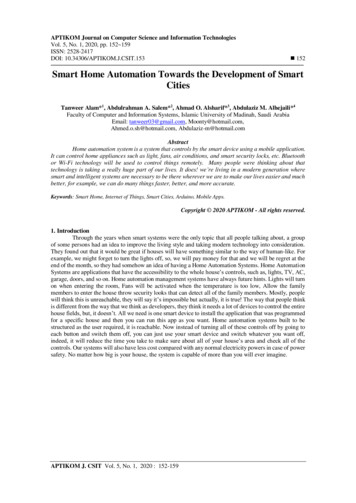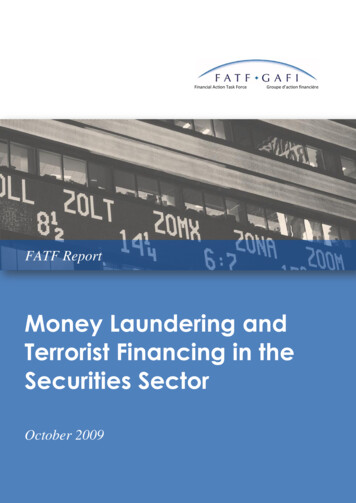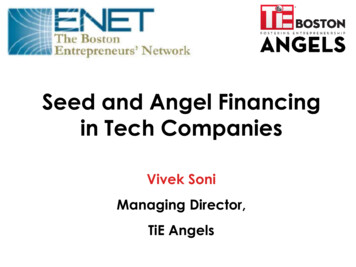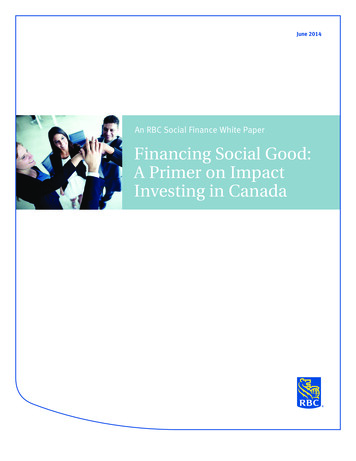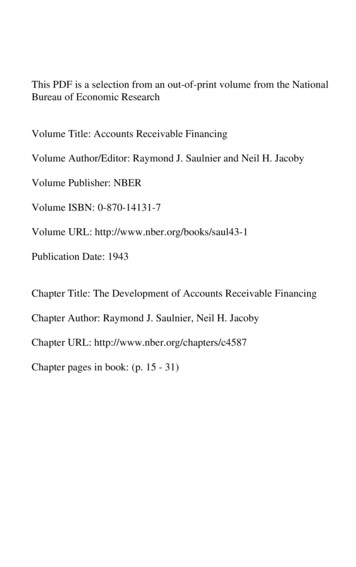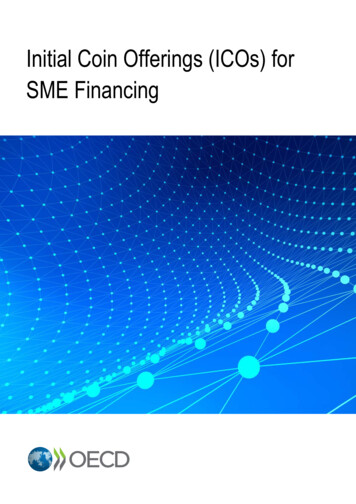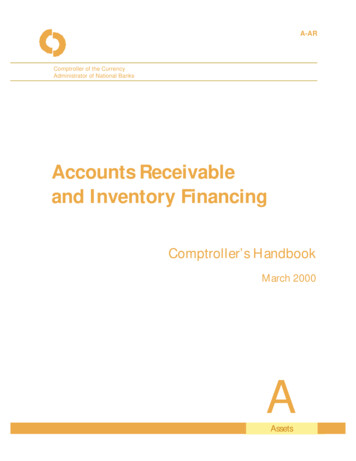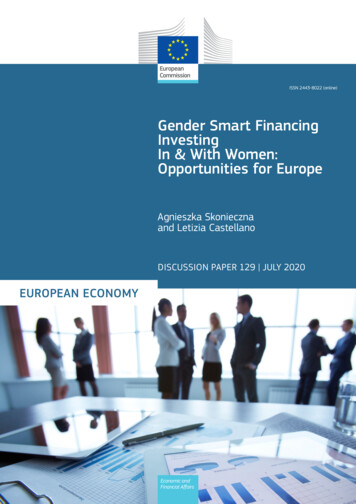
Transcription
ISSN 2443-8022 (online)Gender Smart FinancingInvestingIn & With Women:Opportunities for EuropeAgnieszka Skoniecznaand Letizia CastellanoDISCUSSION PAPER 129 JULY 2020EUROPEAN ECONOMYEUROPEANEconomic andFinancial Affairs
European Economy Discussion Papers are written by the staff of the European Commission’sDirectorate-General for Economic and Financial Affairs, or by experts working in association with them, toinform discussion on economic policy and to stimulate debate.DISCLAIMERThe views expressed in this document are solely those of the author(s) and do not necessarily represent theofficial views of the European Commission.The closing date for this document was 20 July 2020.Authorised for publication by Kerstin Jorna, Deputy Director-General for Economic and Financial Affairs.LEGAL NOTICENeither the European Commission nor any person acting on behalf of the European Commission is responsiblefor the use that might be made of the information contained in this publication.This paper exists in English only and can be downloaded c-and-financial-affairs-publications en.Luxembourg: Publications Office of the European Union, 2020PDFISBN 978-92-76-11197-9ISSN 2443-8022doi:10.2765/511657KC-BD-19-016-EN-N European Union, 2020Non-commercial reproduction is authorised provided the source is acknowledged. For any use or reproductionof material that is not under the EU copyright, permission must be sought directly from the copyright holders.CREDITCover photography: iStock.com/shironosov
European CommissionDirectorate-General for Economic and Financial AffairsGender Smart FinancingInvesting In and With Women: Opportunities for EuropeAgnieszka Skonieczna and Letizia CastellanoAbstractGender-diverse teams produce better results. However, women remain underrepresented when it comes toinvestment, both as beneficiaries of investment and as decision-makers. In 2018, over 90% of capital raisedby tech companies backed by European venture capital (VC) went to teams that did not have a singlefemale founder. This paper discusses the reasons behind the gender investment gap, with a focus on thelack of female investors.Women’s wealth is on the rise and women tend to invest in more long-term and impactful projects.Investing in and with women is thus an opportunity that Europe needs to seize for more sustainable andinclusive growth. InvestEU, the EU investment programme as of 2021, could act as a catalyst of thesebenefits by stimulating gender-smart financing, i.e. financing that funds, empowers and inspires femalefounders and investors.JEL classification: G20, G30, O16.Keywords: gender-smart financing, investment gap, diversity in business, women investors, femaleinvestors, gender gap, financing instruments, InvestEU, EU investment programme, economic growth,sustainability.Acknowledgements: Special contributions to the paper were provided by Agnieszka Wojdyr (DGGROW), Katerina Borunska (DG RTD), Polyvios Eliofotou (DG EMPL), Georgia Efremova, Janka Petoczand Marina Vatchkova (DG ECFIN).Comments and suggestions from Giorgio Chiarion Casoni, Vladimir Bilek, Filippo Munisteri and AnneKingma (DG ECFIN) have been incorporated and are gratefully acknowledged.The data collection and overall consistency of the paper benefited from contributions from Oumnia Alaoui,Ester Berlot, Oliviero Maria Bertoni, Martyna Chmiel, Isil Degerli, Marco Franzetti, Andras Hajdo, MartinaRavaglia, Giorgio Ricciuti and Luca Scrascia (DG ECFIN).Special thanks go to the speakers and participants at the ‘Breakfast on gender smart financing’ event (20November 2019).Contact: Agnieszka Skonieczna, European Commission, Cabinet of Commissioner Thierry Breton,agnieszka-maria.skonieczna@ec.europa.eu; Letizia Castellano, European Commission, Directorate-Generalfor Economic and Financial Affairs, letizia.castellano@ec.europa.eu.EUROPEAN ECONOMYDiscussion Paper 129
CONTENTS1.Context. 42.Introduction . 43.Why is there a need for action?. 53.1.Diversity matters for the bottom-line 53.2. however, little capital goes to female-led companies.53.3.Why is it more difficult for women to raise money?73.4.More female investors: the answer for more gender-diversE and socialinvestment?84.Current landscape of initiatives to support gender-diverse investment inEurope. 95.Exploring the avenues . 115.1.Investing115.2.Nurturing125.3.Stimulating change13REFERENCES. 17ANNEX. 20
1.CONTEXTEquality between men and women in education, economic decision-making and political power, andwomen’s economic independence and equal earning potential are key for Europe’s future and featurestrongly on the EU’s agenda. The European Commission’s strategic engagement for gender equalityset the framework for EU action in 2016-2019 to promote equality between women and men, as one ofthe Union’s fundamental values. The good news is that progress is being made. However, this progresscould be accelerated1.The von der Leyen Commission has recently communicated the new gender strategy for the period2020-20252, presented as one of the priorities of the new Commission. The strategy underlines theimportance of gender equality for achieving an economy that works for people, including when itcomes to female representation and involvement in the financial environment. The gender priority isreiterated also in other key Commission documents, notably in the Recovery Plan for Europepackage3, the massive and innovative long-term EU budget boosted by Next Generation EU4, which isaiming at recovering the economy while making it greener, fairer, more digital and resilient; and in theproposal for vocational education and training5, in which one of the objectives is to promote equalityof opportunities, including promoting gender balance between traditional ‘male’ and ‘female’professions by encouraging participation in vocational training.InvestEU, the new investment programme to be launched in 2021 under the 2021-2027 multiannualfinancial framework and financed by the Next Generation EU, is aimed at mobilising private andpublic investment in Europe for more sustainable, inclusive and innovative growth. It places a clearfocus on social investment and a strong emphasis on measures to promote gender equality6.This paper argues that empowering women as founders and investors is crucial to the achievement ofthe InvestEU goals. Women tend to be associated with long-term, patient capital and moresocial-impact investment. Women’s wealth is on the rise and represents a huge economic opportunityto accelerate change towards a more diverse and sustainable financial system. There is evidence thatwomen entrepreneurs are missing out on funding all over the world7. On the basis of current trends, itwill take 202 years to close completely the gender gap in economic participation and opportunity8.2.INTRODUCTIONTraditionally, women feature as beneficiaries of social investment, as accessing finance is moredifficult for women entrepreneurs than it is for male entrepreneurs (European Commission & OECD,2017; Leitch et al., 2018). This stems from a range of factors on the demand and supply side. Womenentrepreneurs might choose different business sectors, which in turn plays a part in fuelling thefunding gap (European Parliament, 2015), but there also seems to be a gender bias on the investors’1European Commission, 2019 report on equality between women and men in the EU.2Gender Equality Strategy 2020 – 2025 COM(2020)152 final, 04.03.20203The EU budget powering the recovery plan for Europe COM(2020) 442 final, 27.5.2020Europe's moment: Repair and Prepare for the Next Generation COM(2020) 456 final, 27.5.2020Proposal for a Council Recommendation on vocational education and training (VET) for sustainable competitiveness,social fairness and resilience SWD(2020) 123 final, 1.7.2020e.g. Article 7 of the partial agreement on the Proposal for a regulation of the European Parliament and of the Councilestablishing the InvestEU Programme COM/2018/439 final - 2018/0229 (COD) as amended by the European Parliament.e.g. forthcoming study by EIB InnovFin Advisory, Why are female entrepreneurs missing out on funding? (see section 4).As estimated by the World Economic Forum (2018); see annex to this discussion paper.456784
side. There is an increasing focus on diversity and motivations of the providers of finance, driving thesupply side. At the turn of the century, a literature review concluded that only a limited proportion ofstudies on gender investigated women’s experience in accessing equity investment (Leitch and Hill,2015). Nowadays, social media and the press, in particular in the United States, feature many femalefounders and investors denouncing the lack of diversity in the investment community and launchingtheir own ventures, thereby helping to change the status quo. Women are no longer simply thebeneficiaries of social finance, but the drivers of a sustainable investment ecosystem that has femalefinancial power at its heart.3.WHY IS THERE A NEED FOR ACTION?3.1.DIVERSITY MATTERS FOR THE BOTTOM-LINE Diverse teams exhibit stronger returns and outperform market benchmarks (Christiansen et al., 2016).Greater gender diversity is correlated with higher profitability, innovation and value creation(McKinsey & Company, 2015; Nordea, 2018). It also has significant macroeconomic effects in termsof GDP growth, higher productivity and rising wages (Lagarde and Ostry, 2018; Ostry et al., 2018).The European Institute for Gender Equality (EIGE, 2017) estimates that the implementation of genderequality measures in our economy and society could lead to an increase in per capita GDP of up to10% in EU Member States. Similar studies estimate that increasing the presence of women in digitaljobs could boost EU GDP by around 16 billion thanks to more diverse innovation processes,management and marketing practices (European Commission, 2018) and that with equalentrepreneurial participation, global GDP could rise by 3-6%, boosting the world economy byUSD 2.5-5 trillion (Boston Consulting Group, 2019).Women-led companies tend to require less VC while delivering higher returns. In a Boston ConsultingGroup study (2018), women outperformed their male counterparts despite raising less money. Forevery dollar of investment raised, female-run start-ups generated 78 cents in revenue, whereas malerun start-ups generated only 31 cents. A survey of nearly 600 founders found that those who were partof a team with a female founder performed 63% better than all-male counterparts (First Year Capital,2015).3.2. HOWEVER, LITTLE CAPITAL GOES TO FEMALE-LED COMPANIES.While women represent more than half of the EU population and create roughly a third of companies,female entrepreneurs have more difficulties than men in raising finance for their ventures.Women-led businesses are often under-capitalised and use less external financing, relying more onpersonal savings and spousal funds (OECD, 2018). They attract less early-stage equity investment: According to Atomico’s report on The state of European tech 2018, in Europe, VC backedtech companies with all-male founding teams receive 93% of the capital invested and accountfor 85% of deals. 5% of capital goes to mixed teams and only 2% to all-female teams. Therehas been no improvement in recent years. In the USA, about 3% of VC goes to all female-founded companies. Only about 15% goes tocompanies that have at least one women in the founding team. In the EU, companies with atleast one female founder secure about 11% of overall VC funding (PitchBook, 2018 and EIB’sInnovFin Advisory, 2019). For every 1 of VC investment in the UK, all-female founder teams get less than 1 p, all-malefounder teams get 89 p, and mixed-gender teams 10 p. At current rates, it will take more than25 years for all-female teams to reach even 10% of all deals in the UK (British Business Bank,2017).5
TechLeap.NL (2019) estimates that 16% of VC firms invest in Dutch mixed- andfemale-founded start-ups, which receive only 3.5% of total start-up funding. Since 2008, lessthan 1% of all investments have gone to start-ups with only female founders. According to the first SISTA x Boston Consulting Group barometer on inequalities inwomen’s access to finance (2019), women-founded start-ups account for only 5% of allstart-ups funded in France and have 30% less chance of being financed by main investors thanmen-founded counterparts. The imbalance increases for later stages of funding (i.e. series A).6
Graph 1. Gender investment gap in the EUSources: Eurostat (2018), employment statistics. Atomico (2018), The state of European tech 2018.3.3.WHY IS IT MORE DIFFICULT FOR WOMEN TO RAISE MONEY?There are several reasons for the funding gap for female entrepreneurs. They include both demandand supply-side factors, and institutional and cultural biases.Women are less likely to be entrepreneurs in the first place. For example, women in Europe arehalf as likely as men to be self-employed (Eurostat, 2018). The difference is often attributed todifferent levels of human capital (women perceive themselves as having less entrepreneurialexperience than men), social capital
set the framework for EU action in 2016-2019 to promote equality between women and men, as one of the Union’s fundamental values. The good news is that progress is being made. However, this progress could be accelerated1. The von der Leyen Commission has recently communicated the new gender strategy for the period

